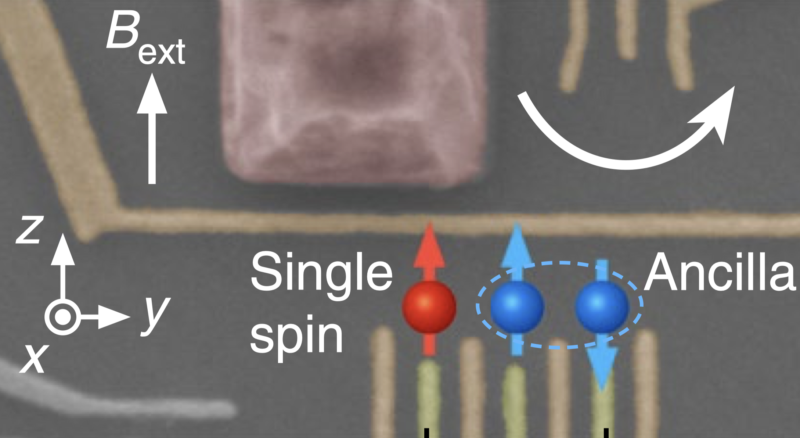
I suspect that if you asked an engineer at Intel about quantum computing, they probably wouldn’t want to know about it unless the chips could be fabricated using standard fabrication technology. Using standard processes means using electrons as the basis for quantum computing.
Electrons are lovely in many respects, but they are rather extroverted. It doesn’t matter what you do, they will run off and play with the neighbors. The constantly interacting electron does not look after its quantum state, so quantum information is rapidly lost, making processing really difficult. This makes the achievement of a quantum non-demolition measurement in an electron system rather remarkable.
Don’t demolish my quantum state
So, what is a quantum non-demolition measurement? Let’s start with the quantum state of an electron. Electrons have a property called spin. For any given orientation (let’s choose vertical), the electron’s spin can take on two values: up and down. I can measure and set these states: I set the state to up and measure the state to be up, for instance. But, this is a quantum property, so we can also set the state to be some mixture of the two, say 50 percent up and 50 percent down. This is called quantum superposition.
However, we do not have the same freedom with our measurement. A measurement can only report up or down, not a percentage of each. Hence a measurement demolishes the quantum superposition state and leaves the electron in a pure state of either up or down. The percentages in the quantum superposition state? They represent the chance that a measurement will result in that outcome.
The goal of a quantum non-demolition measurement is to obtain as much information as possible about the quantum state without changing those probabilities.
Swinging on a spin
Rather than describing quantum non-demolition in general, let’s focus on how the researchers read out the spin of their electron. This new experiment consists of a row of three very cold, very tiny boxes, called quantum dots. Each dot contains a single electron that is confined by the box. The left-most electron holds the state we want to measure—let’s call it the qubit (a quantum bit). We are going to measure it by reading out the combined state of the center and right electrons, which we will call the probe.
We start by preparing the qubit in some superposition state: a mixture of up and down. Then we prepare the probe in a known state (a combination of up/down and down/up). Now, for a very short time, a microwave signal allows the qubit to influence the probe state. A short time later, we measure the probe state. The result of the probe state does not tell us the exact state of the qubit. Instead, it tells us which state is the most likely outcome of a measurement. One measurement like this is not very useful and as the researchers discovered, not very accurate.
But, we can repeat the measurement many times while the qubit is still alive. The researchers showed that they steadily improve their estimate of the quantum state for up to 60 measurements, with a resulting fidelity of nearly 90 percent (fidelity is the probability of setting a state and measuring a state being consistent with each other).
Here, the researchers run into the problem that the qubit’s lifetime is too short. Essentially, the electron is being pushed and pulled by every magnetic and electric field in the vicinity. This modifies the quantum state in random ways and rapidly destroys the information held by the qubit.
Moving to silicon
The researchers note that moving to silicon would reap significant benefits. Using a model of their experiment and some of the known properties of silicon quantum dots, the researchers showed that fidelities in excess of 99 percent are possible. Indeed, the researchers claim that if they can repeat their experiment in silicon, it should be possible to implement qubits that do not need error correction.
That last result may be the most significant part of the paper. Quantum error-correction builds in redundancy by encoding information across multiple qubits. Typical schemes involve seven qubits per logical qubit. With qubits at such a premium, this is simply too expensive to implement. Hence the focus on high-fidelity qubits that don’t need error correction. A standard fabrication process that results in qubits that don’t need error correction would be a pretty huge step.
Nature Communications, 2019, DOI: 10.1038/s41565-019-0426-x (About DOIs)
reader comments
34